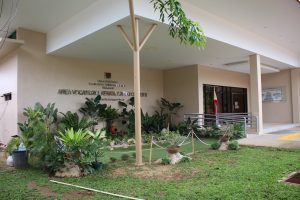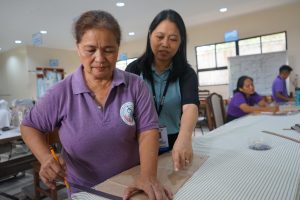The agency celebrates the 20th Women with Disability Day (WDD) with the theme Lipunang Patas sa Bagong Pilipinas: Kakayahan ng Kababaihang may Kapansanan, Patutunayan! It aims to feature inspiring women with disabilities for their resilience, achievements, and contributions to their communities.
Pursuant to Proclamation No. 744, declaring the last Monday of March of Every Year as Women with Disabilities Day, DSWD 7 reminds the public of the programs and services available for women with disabilities.
To advocate for the celebration, the PWD welfare sector hosted an orientation on Republic Act 11313, or the Safe Spaces Act, also known as Bawal Bastos Law, among the trainees and staff of the Area Vocational Rehabilitation Center (AVRC) II. It allows the participants to address gender-based sexual harassment, both online and offline, while promoting equal respect for all individuals, regardless of their gender or disabilities.
On the same day, PWD focal person Margie D. Pinton joined the celebration of the WWD of LGU Mandaue City by promoting the training courses offered by AVRC II, while a special gathering of women members of the Regional Federation of Persons with Disabilities (RFPWD) was hosted by AVRC II to honor their contributions to the sector.
Both activities aim to spread awareness of the celebration and recognize women leaders and advocates who continue to push for the rights of their fellow PWDs.
The Day’s celebration is also an opportunity for the agency to highlight programs for the sector through a radio interview that talked about the celebration and interventions provided by DSWD 7.
Vocational rehabilitation
AVRC II, a non-residential facility situated in Brgy. Labangon, Cebu City, caters to PWD in the three (3) Visayas regions through the provision of vocational rehabilitation to individuals who are willing to undergo skills, livelihood improvement, and employability training.

The facility aims to help PWDs, especially women with disabilities, establish sustainable and independent living after a one-year helping process. It also caters to women in especially difficult circumstances, or WEDCs, like victim-survivors of abuse, particularly those referred to from other facilities.
Free training courses are offered, such as computer systems servicing; electronics products assembly and servicing; basic cosmetology, which includes beauty, nail, and hair care; massage therapy; dressmaking; commercial cooking, which includes bread and pastry production and food processing and preservation; and domestic work like housekeeping and food and beverage preparation, all of which are equivalent to the national certification acquired from the Technical Education and Skills Development Authority (TESDA).
Alongside are psychosocial support and gratuity pay to cover food, lodging, and transportation needs while undergoing rehabilitation.
Basic braille classes and sign language sessions are also offered to those with no formal training and forced savings to teach them the basics of financial literacy.
“We want our trainees to become proactive members of their community by leading their families, supporting their own needs and those of their families, and potentially becoming catalysts for empowering other PWDs or even non-PWDs,” said Pinton during the radio interview.
Pinton, who heads the facility’s social services section, shared that through a comprehensive helping process, AVRC II puts the best interests of trainees first by helping them decide which path they want to take, either for livelihood or employment.
Rehabilitative care includes an assessment of what kind of training course will be appropriate for them and other social interventions such as medical, psychological, and other services needed by a PWD.
To be admitted to the facility, they can go to their LGUs, either through Social Welfare and Development Office or Persons with Disability Affairs Office, to get a referral and prepare their social case summary report to assess them what other support they need, like financial assistance or medical examinations, which are prerequisites upon admission. They may also walk into the facility from Monday to Friday between 8am to 5pm.
Opportunities
“Sa wala pa ko misulod sa AVRC II, daghan ang wala nidasig nako nga wala koy paingnan kay gawas sa babaye ko, tiguwang na ko, ug aduna pud koy apan sa panglawas. Pero dili kini babag aron molihok ko ug mangita og kaayohan para sa akong kaugalingon,” said Victoria Agudo, a 59-year old dressmaking trainee.
After her training, Agudo started her sewing business at home by accepting orders from neighbors and other referrals to meet her daily sustenance. This came after she received a brand-new sewing machine from the rewards system of the facility.

The rewards system is a mechanism employed by AVRC II to encourage productivity among the trainees with no absenteeism and/or compliance with various training requirements. The reward is given at the end of the training period and these usually come in the form of resources or equipment for livelihood opportunities that will aid them towards sustainable and independent living.
The goal of AVRC II is to improve individual well-being so that PWDs can stand on their own after their rehabilitation and this can be done through the training courses along with values formation, social interaction, and capacity-building. Most importantly, for PWDs to accept and acknowledge their inherent disabilities by providing them with dignity so they can live freely and equally just like others.
Suzette Juico, a 46 year-old hearing impaired, is one of the trainees of a commercial cooking program. She shared that the experience she got from the facility is a stepping stone for her to be employed for the first time and hopefully gain enough savings so she can start her own business one day.
Aside from that, she also shared that the outputs or products from their daily session, like ‘merienda’ or snacks, were sold to fellow trainees or even staff of the facility. Their earnings on top of the gratuity she received helped her during the training period.
“Niangat ang akong pagpuyo isip usa ka PWD. Pinaagi sa akong mga nakat-unan nga pwede nakong magamit sa pag-negosyo pohon, dili sab ka nila pasagdan kay motabang sila sa pagpangita og trabaho o employer para nimo,” she happily shared about the manpower placement feature of AVRC II.
Like Agudo, she also received a reward from the facility. “Sobra pa sa makina akong nadawat. Hearing aid nga nagkantidad og Php 50,000 nga akong gipangandoy,”
The agency aims that no PWDs will be left behind and that their families will mainstream them in society to avail of services appropriate for them. “Let us not hide our family members who are PWD from society. They have rights, dignity, and potential to make their lives better and contribute to our society,” Pinton encouraged the public.
As of the first quarter of 2024, AVRC II caters to 136 trainees currently enrolled in the facility undergoing training or on-the-job training. ###
(85) Views